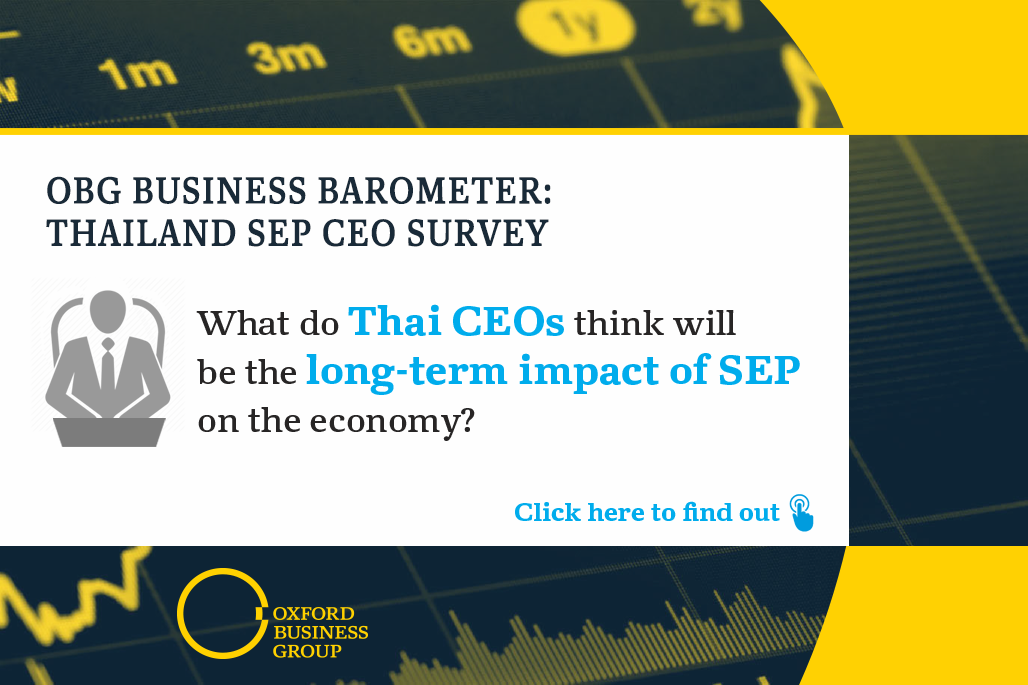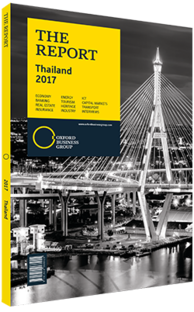Sustainable growth forecast for Thailand in 2017
Located at the heart of South-east Asia, the Kingdom of Thailand covers a total area of 513,120 sq km, making it the 50th largest nation in the world by area. It is bound geographically by the nations of Cambodia to the east, Laos to the north-east, Malaysia to the south and Myanmar to the west. Major natural boundaries include the Andaman Sea and the Gulf of Thailand, which straddle the Kra Isthmus to the west and east, respectively. Thailand’s largest city is Bangkok, which has served as its capital since 1782.
Five Geographic Regions
Thailand is split broadly into five regions: the north, the north-east, known locally as Isan, the east, the centre and the south. Specific regional groupings of provinces, also called changwat, tend to vary. The largest formal sub-divisions are Thailand’s 76 provinces, in addition to the special administrative division of Bangkok, with each containing their own provincial local governments. Governors of the provinces are appointed by the Ministry of the Interior, however the governor of the special administrative division of Bangkok is popularly elected. The provinces and the capital itself are further sub-divided into amphoe, which can be translated as districts. Each region, and to a lesser extent each province, often contains its own geography, climate, culture, cuisine and economy, and the traits of each of these areas vary widely throughout the nation.
The north is characterised by hilly terrain owing to its high elevation, along with a moderate climate in comparison with the tropical clime enjoyed by the majority of the nation. The Isan region is located on the Khorat Plateau and is bound externally by the Mekong River along its border with Laos. The Isan people, culture and cuisine share many similarities with those of Laos. The east and central regions form the economic and industrial engine of the nation, with key infrastructure including airports and seaports, along with an array of industrial estates. The Eastern Economic Corridor – which comprises the three eastern provinces Chachoengsao, Chonburi and Rayong – serves as the nation’s hub for current and future industries, complemented by strong connectivity to Bangkok and its surrounding provinces to the west. Lastly, southern Thailand extends downward from the Malay Peninsula to the land border shared with Malaysia and contains much of the nation’s Muslim population, concentrated within its southernmost provinces.
Demographics
With a population of 68m, as of the most recent 2015 estimate, Thailand is the third-most populous nation in ASEAN following Indonesia and Vietnam, and is the 20th most populous in the world. Bangkok is the most populous city by far with a population of 8.3m, and it forms the cultural and economic hub of the nation. The Bangkok Metropolitan Region, which encompasses the capital along with the adjacent provinces of Samut Sakhon, Nakhon Pathom, Nonthaburi, Pathum Thani and Samut Prakan, from west to east, totals nearly 15m people. Large cities outside of the Bangkok Metropolitan Region include Nakhon Ratchasima, Chiang Mai, Hat Yai and Udon Thani. The largest province outside of the capital is Nakhon Ratchasima, located in the north-east.
Ethnic Thais comprise the vast majority of the population at over 95%, although significant ethnic intermixing has taken place with other groups such as the Chinese for many decades, while notable minorities include people from Myanmar. The majority of the population speaks Thai, the roots of which can be traced to the Tai-Kadai primary language group. Dialects include the predominant central Thai, as well as southern Thai, northern Thai and Laotian, commonly spoken in the north-eastern region of Isan. Population growth in Thailand is estimated at around 0.3%, a relatively low rate compared to that of other South-east Asian nations, and is reflective of its ageing population.
Culture & Religion
Buddhism is the largest religion in Thailand, practiced by around 94.6% of the population. The predominant branch of Buddhism in practice is Theravada Buddhism, which considers the Pali Canon collection of scriptures as its doctrine, and is also the dominant religion in Cambodia, Laos, Myanmar and Sri Lanka, while being practiced by minority populations further afield in Asia. Theravada Buddhism’s strong role in the kingdom’s identity extends to the national flag, with the two white stripes representing Buddhism, the red stripes at the extremes representing the colour of the nation, and the blue stripe at the centre representing the monarchy. Buddhist temples, shrines and statues, often decorated in gold, are ubiquitous to the Thai landscape, and the religion’s influence is felt in national art, literature and architecture as well. The seven days of the week are each associated with a Buddhist colour; yellow for Monday, pink for Tuesday, green for Wednesday, orange for Thursday, blue for Friday, purple for Saturday and red for Sunday. It is not uncommon for local dress to adopt this colour coordination, and it is considered a sign of respect for visitors to follow suit. Other religions in Thailand include Islam, which is practised by about 4.6% of the population and forms the religious majority in the southernmost provinces of Satun, Yala, Pattani and Narathiwat; and Christianity, which is practiced by about 0.7% of Thais.
Environment & Climate
Thailand is home to a rich array of natural resources, including metals such as gold, tin, tungsten, tantalum, zinc, iron and silver, as well as energy resources encompassing both onshore and offshore oil and gas fields. Outside of oil and gas, Thailand has accelerated its harnessing of renewable energies, including solar, wind and biomass in recent years, as part of its drive towards energy security and diversification. Thailand’s other natural resources include natural gas, fluorite, gypsum, lignite, rubber, timber, and agricultural and fish products.
The Koppen Climate classification system lists Thailand as having a tropical monsoon climate, featuring warm temperatures and high humidity throughout the year. The rainy season differs between the west and east coasts, with south-west monsoons bringing heavy storms between April and October, and east coast rains most often falling from September to December. The nation’s elevated northern region is characterised as having a greater degree of seasonal variation.
History
The Kingdom of Thailand was formally established in the 14th century, with the Sukothai and Ayuttaya kingdoms generally considered as the predecessors to the modern state. It is the only South-east Asian nation never to be formally colonised, despite brief periods of occupation, owing to its strategic location between two major colonial powers and the strength of its diplomacy. The 1896 Anglo-French accord guaranteed the kingdom its independence and cemented its role as a buffer between English and French colonies and other interests in the greater region. In 1932 a constitutional monarchy was established in Thailand following a coup, with a representative government based on universal suffrage. The kingdom was known as Siam until its name changed in 1939, and was briefly renamed Siam again between 1945 and 1949.
Economy
Thailand’s GDP growth accelerated throughout the early 2000s, peaking at 7% in 2003 and not dropping below 5% until the 2007-08 global financial crisis. The effects of the crisis lasted two years and recovery was turbulent: with the Kingdom achieving negative growth in 2009 before rebounding to 7.5% growth the following year and dropping again to below 1% in 2011. Political unrest and government policy brought on another decline in economic growth in 2013 and 2014, with World Bank data showing GDP growth at 2.8% and 0.9%, respectively. GDP growth has accelerated in recent years, as 2015 saw an increase of 2.9%, followed by a slightly stronger posting of 3.2% in 2016. Forecasts indicate an anticipated GDP expansion of about 3.5% in 2017, buoyed by the strong promotion of new industries, high-growth areas such as the Eastern Economic Corridor, and increased spending on infrastructure development and expansion projects.
You have reached the limit of premium articles you can view for free.
Choose from the options below to purchase print or digital editions of our Reports. You can also purchase a website subscription giving you unlimited access to all of our Reports online for 12 months.
If you have already purchased this Report or have a website subscription, please login to continue.


